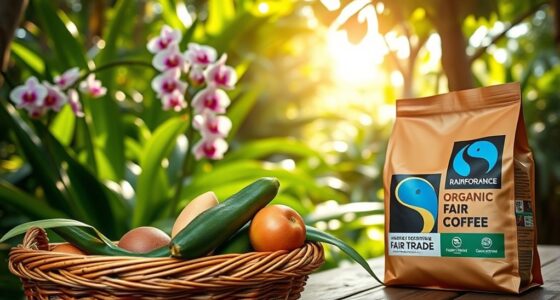Choosing shade-grown coffee benefits the environment and offers richer flavors. Shade-grown coffee is cultivated under native trees, supporting biodiversity and natural pest control, which reduces chemical use. It also promotes sustainable farming and crop diversification. In contrast, sun-grown coffee often harms ecosystems through land clearing and chemical dependence, resulting in less complex beans. If you want to discover how these differences impact taste and ecology, there’s more to explore below.
Key Takeaways
- Shade-grown coffee supports biodiversity by preserving native trees and ecosystems, unlike sun-grown coffee which often causes habitat loss.
- Shade-grown beans develop richer, more complex flavors due to slower, even maturation under canopy cover.
- Shade cultivation reduces the need for chemical pesticides by attracting natural pest predators, promoting eco-friendly farming.
- Sun-grown coffee typically involves monoculture and chemical inputs, leading to environmental degradation and lower ecological resilience.
- Shade-grown practices enhance farm sustainability through crop diversification and soil conservation, benefiting both environment and long-term productivity.

Have you ever wondered how the way coffee is grown impacts the environment and the flavor in your cup? When you choose shade-grown coffee over sun-grown varieties, you’re making a decision that can positively influence both the planet and the quality of your brew. Shade-grown coffee is cultivated beneath a canopy of native trees, which creates a more balanced ecosystem. This environment naturally enhances pest resistance because the diverse plant life attracts beneficial insects and birds that prey on pests, reducing the need for chemical pesticides. As a result, your coffee is less likely to contain residues from harmful chemicals, and the overall health of the farm’s ecosystem is preserved. Additionally, crop diversification is a key benefit of shade-grown methods. Farmers often grow other crops alongside coffee, such as bananas or cocoa, which not only boosts their income but also creates a more resilient farming system. This diversification reduces the risk that a single pest or disease will wipe out the entire crop, making farms more sustainable over the long term.
By choosing shade-grown coffee, you’re supporting farming practices that maintain biodiversity and promote ecological balance. The trees provide shade that moderates temperature fluctuations, leading to slower, more even bean maturation. This process allows the beans to develop richer flavors, often resulting in a cup with more nuanced and complex notes. Conversely, sun-grown coffee typically involves clearing large areas of land to maximize sun exposure, which can lead to soil erosion and loss of native vegetation. This method often relies heavily on chemical inputs to combat pests and weeds, which can harm local wildlife and reduce biodiversity. The lack of natural pest resistance in sun-grown coffee means farmers must depend more on pesticides, which can impact the environment and potentially alter the flavor profile of the beans.
Furthermore, shade-grown coffee cultivation supports biodiversity, helping to preserve many species of plants and animals that depend on forest habitats. In essence, shade-grown coffee offers environmental benefits that extend beyond the farm. It promotes pest resistance naturally, reducing the need for chemicals, and encourages crop diversification, which strengthens the farm’s sustainability. These practices help preserve ecosystems, protect wildlife, and produce coffee with richer, more vibrant flavors. When you opt for shade-grown beans, you’re supporting a method of cultivation that values ecological health and flavor complexity. It’s a choice that benefits the environment, the farmers, and your coffee experience—all in one sip. So, next time you pick up your favorite bag, consider how the way it was grown influences not just its taste but the health of the planet.
Frequently Asked Questions
How Does Coffee Cultivation Impact Local Biodiversity?
You impact local biodiversity when you choose shade-grown coffee, as it helps prevent biodiversity loss and promotes habitat preservation. Shade-grown cultivation maintains native trees and plants, supporting various wildlife species. In contrast, sun-grown coffee often leads to habitat destruction, reducing biodiversity. By opting for shade-grown coffee, you contribute to healthier ecosystems and preserve the rich variety of life that depends on coffee-growing regions.
Are Shade-Grown Coffees More Expensive Than Sun-Grown?
Shade-grown coffees are generally more expensive than sun-grown options due to a higher cost difference and a price premium. You’ll often find that shade-grown beans cost more because they require careful cultivation and preserve biodiversity, which adds to production costs. This price premium reflects the environmental benefits and better flavor profiles, making shade-grown coffee a worthwhile choice if you’re willing to pay a bit more for sustainability and quality.
Which Type of Coffee Has a Longer Shelf Life?
You’ll find that shade-grown coffee generally has a longer shelf life than sun-grown, thanks to its richer antioxidant content. Studies show that proper preservation techniques, like airtight containers and cool storage, extend freshness for both types. However, shade-grown beans tend to retain their flavor and aroma longer, making them easier to preserve. So, if shelf life matters, shade-grown coffee might be your best choice for lasting freshness.
Do Shade-Grown Coffees Have Different Caffeine Levels?
You’ll find that shade-grown coffees can have different caffeine levels because of caffeine content variability influenced by growing conditions. Generally, shade-grown beans might have slightly lower or similar caffeine levels compared to sun-grown options. These differences can also affect brewing strength, so you might notice subtle variations in flavor and caffeine punch. Ultimately, your brewing method and bean origin play significant roles in determining your coffee’s caffeine content.
Can Shade-Grown Coffee Be Certified Organic?
Yes, shade-grown coffee can be certified organic. You may face certification challenges like demonstrating eco-friendly farming practices and avoiding synthetic chemicals. To achieve organic certification, you need to work with certifying agencies that verify your farm meets organic standards. This process guarantees your shade-grown coffee aligns with eco-conscious principles, helping you market it as sustainably grown and appealing to environmentally conscious consumers.
Conclusion
Choosing shade-grown coffee lets you enjoy richer flavors while nurturing ecosystems and supporting biodiversity. On the other hand, sun-grown coffee offers higher yields and easier harvesting but often at the expense of the environment. By opting for shade-grown, you savor a more complex cup and protect wildlife. So, next time you sip your coffee, remember—your choice can either sustain the planet or contribute to its decline. Make it count with shade-grown.









